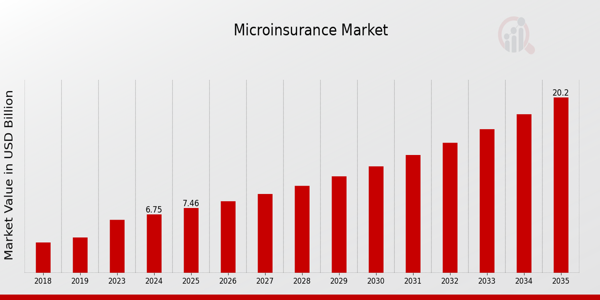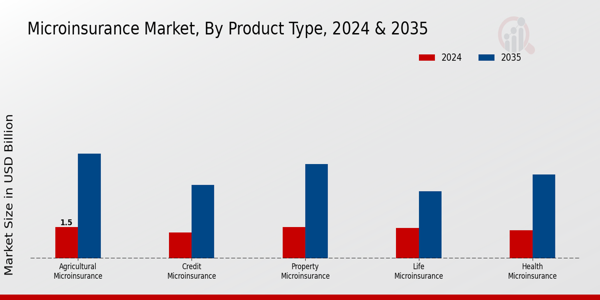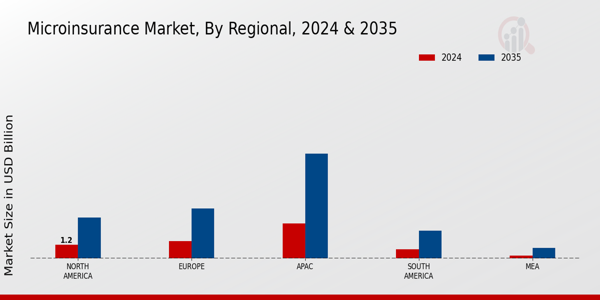Global Microinsurance Market Overview:
Microinsurance Market Size was estimated at 6.11 (USD Billion) in 2023. The Microinsurance Market Industry is expected to grow from 6.75(USD Billion) in 2024 to 20.2 (USD Billion) by 2035. The Microinsurance Market CAGR (growth rate) is expected to be around 10.48% during the forecast period (2025 - 2035).
Key Microinsurance Market Trends Highlighted
The Microinsurance Market has been experiencing several significant trends that shape its landscape. One notable trend is the increasing awareness and acceptance of microinsurance products among low-income populations. Many countries are recognizing the potential of microinsurance to provide financial protection to underserved communities, leading to greater regulatory support and frameworks that encourage innovative offerings. As financial literacy improves, more individuals are seeking accessible insurance solutions to manage risks effectively, driving demand for these products. In recent times, advancements in technology have played a crucial role in transforming the microinsurance sector.
The rise of mobile technology and digital platforms has simplified the distribution and administration of microinsurance products, making them more accessible to remote and rural populations. This technological integration is not just revolutionizing service delivery but is also lowering operational costs for providers, thus making microinsurance more sustainable in the long run. Opportunities remain abundant in the market, particularly in collaboration with non-governmental organizations (NGOs) and community-based groups. These partnerships can enhance outreach and tailor products that meet the unique needs of different communities. Additionally, the potential to expand microinsurance offerings to cover climate risks and health-related issues is increasingly becoming evident, as these areas are crucial for vulnerable populations worldwide.
Overall, the interplay between increasing awareness, technological advancement, and strategic partnerships is fueling the growth of the Microinsurance Market. This environment creates a fertile ground for innovation and expansion, ultimately aiming to foster financial inclusion on a scale.

Source: Primary Research, Secondary Research, MRFR Database and Analyst Review
Microinsurance Market Drivers
Increasing Financial Inclusion through Digital Platforms
The growing use of digital platforms that provide low-income populations access to financial services is propelling the microinsurance market industry's notable expansion. There is a huge market for microinsurance products that can help the 1.7 billion people who do not have access to banking, according to the World Bank. Low premiums and easily accessible plans are now possible because of the innovation and diversification of insurance providers made possible by digital technologies.
Leading this movement are companies like Bima and MicroEnsure, which use mobile technology to provide insurance products to underprivileged areas. More than 80% of people in poor nations already own a cell phone, which makes it easier to advertise microinsurance products. It is anticipated that this technological integration would improve the channels of distribution and boost insurance adoption, promoting widespread financial inclusion and propelling the expansion of the microinsurance market industry.
Rising Awareness about Insurance Benefits
An increase in the general public's awareness of the benefits of insurance is significantly driving the Microinsurance Market Industry. In many developing countries, educational initiatives sponsored by organizations like the International Labour Organization have contributed to heightened awareness of different insurance products and their importance in risk management. A survey conducted by the International Association of Insurance Supervisors revealed that about 60% of informal sector workers are now aware of microinsurance options, a marked increase from previous years.
As knowledge spreads, demand is likely to rise, facilitating further market expansion and promoting stability among low-income households who are vulnerable to economic shocks.
Government Initiatives Promoting Microinsurance
Various governments across the globe are establishing policies aimed at promoting microinsurance as a viable risk management tool for low-income populations. For instance, the Indian government has launched the Pradhan Mantri Fasal Bima Yojana scheme, which aims to provide affordable crop insurance to farmers. Such initiatives are indicative of a growing recognition of the role that microinsurance can play in poverty alleviation and economic development.
Similarly, in countries like Kenya, the government supports partnerships with microinsurance providers to ensure broad access to affordable insurance. Such policy frameworks are essential for the proliferation of microinsurance products, which in turn drives the Microinsurance Market Industry as further support from regulatory bodies enhances consumer confidence and encourages investment in microinsurance solutions.
Microinsurance Market Segment Insights:
Microinsurance Market Product Type Insights
The Microinsurance Market, with a valuation of 6.75 USD Billion in 2024, is a rapidly growing field characterized by various product types catering to different consumer needs. Within this sector, Health Microinsurance emerges as a crucial product, valued at 1.35 USD Billion in 2024, reflecting the increasing need for affordable healthcare solutions for low-income populations. By 2035, its value is projected to grow to 4.0 USD Billion, which emphasizes its significance in addressing rising health costs and expanding access to medical services.
Credit Microinsurance also plays a vital role, valued at 1.25 USD Billion in 2024 and expected to expand to 3.5 USD Billion by 2035. This product type is largely pivotal in protecting low-income borrowers against unforeseen circumstances that could hinder their ability to repay loans, thereby fostering financial stability and economic empowerment within communities. Agricultural Microinsurance, valued at 1.5 USD Billion in 2024, anticipates growth to 5.0 USD Billion by 2035, highlighting its importance in safeguarding farmers against climate-related risks and ensuring food security.
Given that agriculture is a primary livelihood for many in developing nations, this product type holds a significant majority share within the market. Property Microinsurance, similarly valued at 1.5 USD Billion in 2024 and expected to reach 4.5 USD Billion by 2035, is integral for protecting low-income households against asset loss from natural disasters and other perils, which can impact community resilience. Life Microinsurance, with a valuation of 1.45 USD Billion in 2024, is anticipated to grow to 3.2 USD Billion by 2035. It addresses the pressing need for financial protection for families in the event of the head of household's demise, ensuring a safety net for dependents.
The collective growth in these product types reflects the increasing awareness of the benefits of microinsurance and the rising demand from underserved populations around the globe. Each segment addresses specific needs, demonstrating their significant roles in financial inclusion, risk management, and community development, ultimately contributing to enhanced livelihoods and stability within the market landscape. The trends indicated by Microinsurance Market data show how microinsurance caters to specific risks faced by underserved populations, creating new opportunities for the industry amid ongoing challenges.
Market growth is further supported by broader digital transformation in financial services, allowing for innovative distribution channels and the development of personalized products to meet the demands of diverse customer bases in various regions globally.

Source: Primary Research, Secondary Research, MRFR Database and Analyst Review
Microinsurance Market Distribution Channel Insights
The Microinsurance Market, specifically through its Distribution Channel segment, exhibits a diverse landscape, with various channels playing critical roles in delivering insurance products to underserved populations. In 2024, the overall market is valued at 6.75 billion USD, reflecting a growing recognition of microinsurance as a valuable tool for risk mitigation. Each distribution channel, including Banks, Microfinance Institutions, Cooperatives, Insurance Companies, and Online Platforms, contributes uniquely to market growth.
For instance, Microfinance Institutions have become vital for reaching low-income households, providing a trusted means of access to insurance services, while Online Platforms leverage technology to enhance customer engagement and streamline processes. Meanwhile, Insurance Companies reiterate the necessity of tailored products that address specific community needs, dominating the market with their established credibility. Overall, this segment is characterized by increasing partnerships among various channels and adaptive strategies designed to meet the unique needs of diverse demographic groups.
The focus remains on expanding access and improving financial inclusion, which is essential for the sustainable growth of the Microinsurance Market. Furthermore, regulatory support and positive government initiatives are fostering a conducive environment for these distribution channels to thrive, ultimately driving market development.
Microinsurance Market Customer Demographics Insights
The Microinsurance Market is poised for significant growth, valued at 6.75 Billion USD in 2024. This growth is driven by diverse customer demographics, which include Low-Income Individuals, Smallholder Farmers, Informal Sector Workers, Women Entrepreneurs, and Youth. Each demographic contributes uniquely to the market dynamics. For instance, Low-Income Individuals represent a substantial portion of clients seeking affordable insurance solutions that cater to their limited financial capacity. Similarly, Smallholder Farmers benefit extensively from microinsurance products that protect them against unpredictable weather and adverse conditions, promoting agricultural stability.
Informal Sector Workers, often lacking traditional employment benefits, find value in microinsurance as a means of risk management. Women Entrepreneurs are increasingly recognized for their role in economic development and are targeted for products designed to support female-led businesses. Lastly, the Youth segment, characterized by growing awareness and eagerness to secure financial futures, is becoming an emerging market force. These segments not only drive the Microinsurance Market revenue but also highlight the urgency for tailored solutions addressing their specific insurance needs, ultimately contributing to broader financial inclusion goals globally.
Microinsurance Market Policy Duration Insights
The Microinsurance Market is experiencing notable growth, particularly in the Policy Duration segment, which encompasses distinct categories such as Short-Term, Medium-Term, and Long-Term policies. In 2024, the market is valued at 6.75 billion USD, driven by an increasing demand for affordable insurance options among underprivileged populations. The Short-Term policies are significant as they offer quick access to financial protection for specific events, making them appealing to low-income individuals who need immediate coverage.
In contrast, Medium-Term policies cater to those seeking more comprehensive solutions without long-term commitments, thereby addressing a broader range of needs. Long-Term policies often dominate this market, providing sustained protection and fostering financial security over extended periods, which is crucial in developing economies. Overall, the Microinsurance Market segmentation enables diverse offerings tailored to various consumer requirements, aligning with the overarching trends within the insurance industry, including a focus on financial inclusion and risk management.
These factors contribute to the evolving landscape of the Microinsurance Market, highlighting its potential for growth and expansion in the coming years.
Microinsurance Market Regional Insights
The Microinsurance Market reflects substantial growth across various regions, with anticipated market valuations signifying the increasing importance of microinsurance in risk management, primarily in underserved communities. In 2024, the North American is valued at 1.2 USD Billion, while Europe presents a slightly higher valuation of 1.5 USD Billion, showcasing a significant interest in microinsurance products in developed markets. The APAC region leads the Microinsurance Market with a notable valuation of 3.0 USD Billion in 2024, dominating due to its vast population and rising awareness of financial inclusivity.
South America and the Middle East and Africa (MEA) are growing segments, valued at 0.8 USD Billion and 0.25 USD Billion, respectively in 2024, indicating emerging opportunities in these regions where access to traditional insurance remains limited. APAC's majority holding underscores how demographic factors and economic development are driving market penetration, while North America and Europe capitalize on regulatory frameworks encouraging microinsurance expansion. The increasing unmet insurance needs in these regions create a fertile ground for innovation and tailored solutions, contributing to overall Microinsurance Market revenue.

Source: Primary Research, Secondary Research, MRFR Database and Analyst Review
Microinsurance Market Key Players and Competitive Insights:
The Microinsurance Market presents a unique landscape characterized by a diverse range of product offerings and competitive players striving to cater to the emerging needs of low-income populations. This segment of the insurance market is designed to provide affordable risk management solutions to individuals who may not have access to traditional insurance products. The competitive insights reveal a dynamic environment where companies are constantly innovating to develop tailored products and adopt new distribution channels. Factors such as economic fluctuations, regulatory developments, and technological advancements significantly influence the strategies employed by market players. As awareness around microinsurance rises, new entrants are attempting to make their mark, creating a vibrant and competitive ecosystem that remains a focus for industry stakeholders aiming to drive growth and enhance financial inclusion across regions.
Focusing on the strengths of Mutual of Omaha within the Microinsurance Market, the company is recognized for its robust customer service and financial stability, which enable it to provide reliable insurance solutions tailored for low-income individuals. Its reputation is bolstered by a comprehensive understanding of the unique risks faced by underserved populations, allowing Mutual of Omaha to design innovative products that are both accessible and relevant. Additionally, the company has established strong partnerships with local organizations and community groups, enhancing its market presence and outreach capabilities. Their emphasis on customer education and engagement sets them apart, reflecting a commitment to not only providing insurance coverage but also empowering individuals to effectively manage their finances and risks.
Regarding Bharti AXA in the Microinsurance Market, the company demonstrates a solid presence characterized by a variety of key products aimed at the low-income segment. Their offerings typically include health microinsurance, agricultural insurance, and life products designed with affordability in mind. The strengths of Bharti AXA lie in its strategic collaborations and extensive distribution network, which facilitate easier access to microinsurance products across various regions. The company actively pursues mergers and acquisitions to enhance its product portfolio and expand its market reach, reflecting an adaptive approach to the evolving needs of consumers. By prioritizing customer-centric solutions and leveraging technology for improved service delivery, Bharti AXA continues to strengthen its foothold in the microinsurance landscape, contributing to financial inclusion on a scale.
Key Companies in the Microinsurance Market Include:
-
Mutual of Omaha
-
Bharti AXA
-
Bima
-
Zurich
-
Edelweiss Tokio
-
MetLife
-
QBE Insurance
-
Cigna
-
Tata AIG
-
Allianz
-
MicroEnsure
-
Society for Microfinance
-
AXA
-
Prudential
-
HDFC ERGO
Microinsurance Industry Developments
The Microinsurance Market has experienced notable developments recently, primarily characterized by innovations in product offerings and partnerships aimed at expanding access to insurance for underserved populations. Companies such as Mutual of Omaha and Cigna have advanced their strategies, focusing on leveraging technology to improve customer service and accessibility in emerging markets. In August 2023, Bharti AXA launched tailored microinsurance products that cater specifically to rural farmers in India, enhancing financial resilience. The market has also seen growth, with estimates indicating a rise in valuation driven by increased awareness of risk management solutions among low-income households.
Moreover, in September 2023, Zurich announced a collaboration with MicroEnsure to broaden its distribution capabilities in Africa, emphasizing the importance of localized solutions. Mergers and acquisitions have also shaped the landscape, with Edelweiss Tokio acquiring MicroEnsure to enhance its footprint in the Asian market in July 2023. This surge in partnerships and product diversification reflects the industry's commitment to providing accessible insurance options, enabling improved risk management for vulnerable populations worldwide. Major incidents in the last several years, such as technological advancements in October 2022, have further reinforced the significance of microinsurance as a viable solution for financial security globally.
Microinsurance Market Segmentation Insights
Microinsurance Market Product Type Outlook
- Health Microinsurance
- Credit Microinsurance
- Agricultural Microinsurance
- Property Microinsurance
- Life Microinsurance
Microinsurance Market Distribution Channel Outlook
- Banks
- Microfinance Institutions
- Cooperatives
- Insurance Companies
- Online Platforms
Microinsurance Market Customer Demographics Outlook
- Low-Income Individuals
- Smallholder Farmers
- Informal Sector Workers
- Women Entrepreneurs
- Youth
Microinsurance Market Policy Duration Outlook
- Short-Term
- Medium-Term
- Long-Term
Microinsurance Market Regional Outlook
- North America
- Europe
- South America
- Asia Pacific
- Middle East and Africa
|
Report Attribute/Metric
|
Details
|
|
Market Size 2023
|
6.11 (USD Billion)
|
|
Market Size 2024
|
6.75 (USD Billion)
|
|
Market Size 2035
|
20.2 (USD Billion)
|
|
Compound Annual Growth Rate (CAGR)
|
10.48% (2025 - 2035)
|
|
Report Coverage
|
Revenue Forecast, Competitive Landscape, Growth Factors, and Trends
|
|
Base Year
|
2024
|
|
Market Forecast Period
|
2025 - 2035
|
|
Historical Data
|
2019 - 2024
|
|
Market Forecast Units
|
USD Billion
|
|
Key Companies Profiled
|
Mutual of Omaha, Bharti AXA, Bima, Zurich, Edelweiss Tokio, MetLife, QBE Insurance, Cigna, Tata AIG, Allianz, MicroEnsure, Society for Microfinance, AXA, Prudential, HDFC ERGO
|
|
Segments Covered
|
Product Type, Distribution Channel, Customer Demographics, Policy Duration, Regional
|
|
Key Market Opportunities
|
Expanding insurance literacy programs, Digital distribution channels growth, Partnerships with NGOs and fintech, Customized products for underserved segments, Government support for low-income protection
|
|
Key Market Dynamics
|
Affordable premiums, Increasing awareness, Digital distribution channels, Regulatory support, Rising demand for protection
|
|
Countries Covered
|
North America, Europe, APAC, South America, MEA
|
Microinsurance Market Highlights:
Frequently Asked Questions (FAQ) :
The Microinsurance Market is expected to be valued at 6.75 USD Billion in 2024.
By 2035, the Microinsurance Market is anticipated to be valued at 20.2 USD Billion.
The expected compound annual growth rate for the Microinsurance Market from 2025 to 2035 is 10.48%.
The Asia-Pacific region is projected to have the largest market size, valued at 9.0 USD Billion by 2035.
Health Microinsurance is expected to be valued at 1.35 USD Billion in 2024 and 4.0 USD Billion in 2035.
Key players in the Microinsurance Market include Mutual of Omaha, Bharti AXA, Bima, and Zurich, among others.
Agricultural Microinsurance is expected to reach a market value of 5.0 USD Billion by 2035.
The North American market is projected to be valued at 1.2 USD Billion in 2024.
Credit Microinsurance is projected to have a market size of 3.5 USD Billion by 2035.
There are significant growth opportunities for Microinsurance in emerging markets due to increasing awareness and demand for affordable insurance solutions.

















